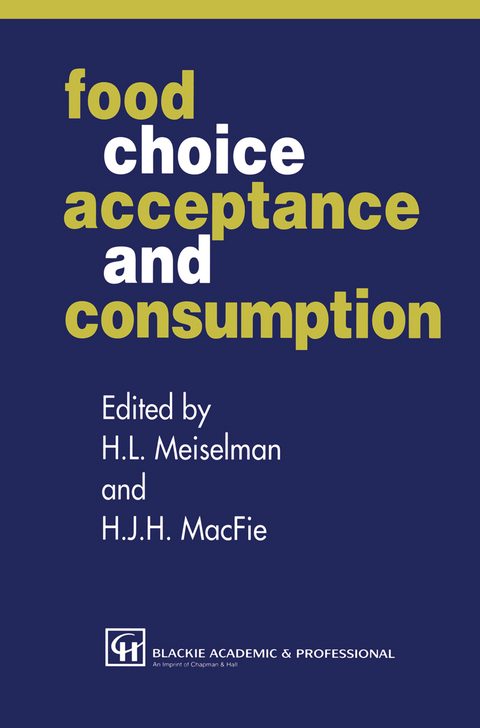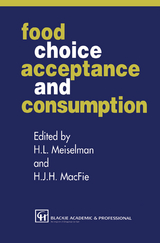Food Choice, Acceptance and Consumption
Chapman and Hall (Verlag)
978-0-7514-0192-9 (ISBN)
1 The role of the human senses in food acceptance.- 1.1 Introduction.- 1.2 The role of vision in food acceptance.- 1.3 The role of somesthesis and kinesthesis in food acceptance.- 1.4 The role of audition in food acceptance.- 1.5 The role of gustation in food acceptance.- 1.6 The role of olfaction in food acceptance.- 1.7 Food acceptance measurement: The relative importance of the senses.- 1.8 Future perspectives.- References.- 2 The socio-cultural context of eating and food choice.- 2.1 Indirect socio-cultural effects.- 2.2 Indirect personal effects.- 2.3 Direct on-line influences.- 2.4 Sociocultural aspects of the acquisition of norms, beliefs, knowledge and attitudes.- 2.5 Conclusion.- Acknowledgements.- References.- 3 What animal research tells us about human eating.- 3.1 Introduction.- 3.2 Methods for studying eating—both strategic and practical.- 3.3 Phenomena of eating in humans uncovered by studies in animals.- 3.4 Theoretical framework and experimental evidence.- 3.5 What animal research tells us about eating disorders in humans.- 3.6 Conclusions and limitations.- Acknowledgements.- References.- 4 The development of children’s eating habits.- 4.1 The frequency and timing of meals.- 4.2 Learning, experience and meal size.- 4.3 Children’s food preferences and food selection.- 4.4 Summary and implications for child feeding.- References.- 5 What does abnormal eating tell us about normal eating?.- 5.1 Introduction.- 5.2 Abnormal eating—quantity.- 5.3 Abnormal eating—speed.- 5.4 Abnormal eating—frequency.- 5.5 Type of food.- 5.6 Internal and extenal cues.- 5.7 Social influence.- 5.8 Precipitants.- 5.9 Conclusions.- References.- 6 The contextual basis for food acceptance, food choice and food intake: the food, the situation and the individual.- 6.1Introduction.- 6.2 The food.- 6.3 The eating situation.- 6.4 The individual.- 6.5 Summary.- References.- 7 Marketing and consumer behaviour with respect to foods.- 7.1 Introduction.- 7.2 Marketing.- 7.3 Marketing strategies at the product and brand level.- 7.4 Marketing tactics: organizing the marketing mix.- 7.5 Consumer orientation in marketing.- 7.6 Food choice behaviour in affluent societies.- 7.7 Implications for food marketing.- 7.8 Illustration: consumer oriented product development.- 7.9 Conclusions.- References.- 8 Economic influences on food choice—non-convenience versus convenience food consumption.- 8.1 Introduction.- 8.2 Time-saving and time-buying strategies.- 8.3 Methodology—data and variables.- 8.4 Food regimes.- 8.5 Statistical model.- 8.6 Estimation results.- 8.7 Conclusion.- Acknowledgement.- References.- 9 Food choice, mood and mental performance: some examples and some mechanisms.- 9.1 Introduction.- 9.2 Effects of foods and food constituents on mood and mental performance.- 9.3 Relationship between the mood and performance effects of foods and food choice.- 9.4 Conclusions.- Acknowledgement.- References.- 10 Attitudes and beliefs in food habits.- 10.1 Models of food choice.- 10.2 Theory of planned behaviour.- 10.3 Extensions of the theory of planned behaviour.- 10.4 Self-identity and organic food consumption.- 10.5 Moral obligation.- 10.6 Conclusions.- Acknowledgements.- References.- 11 Dietary change: changing patterns of eating.- 11.1 Introduction.- 11.2 Sources of evidence for dietary change.- 11.3 Dietary patterns.- 11.4 Factors involved in dietary change.- 11.5 Impact of recommendations on diet and health.- 11.6 Understanding dietary change: future directions.- References.
| Zusatzinfo | XIV, 397 p. |
|---|---|
| Verlagsort | London |
| Sprache | englisch |
| Maße | 155 x 235 mm |
| Themenwelt | Sachbuch/Ratgeber ► Essen / Trinken |
| Sozialwissenschaften ► Soziologie | |
| Technik ► Lebensmitteltechnologie | |
| Wirtschaft ► Betriebswirtschaft / Management | |
| ISBN-10 | 0-7514-0192-7 / 0751401927 |
| ISBN-13 | 978-0-7514-0192-9 / 9780751401929 |
| Zustand | Neuware |
| Haben Sie eine Frage zum Produkt? |
aus dem Bereich




